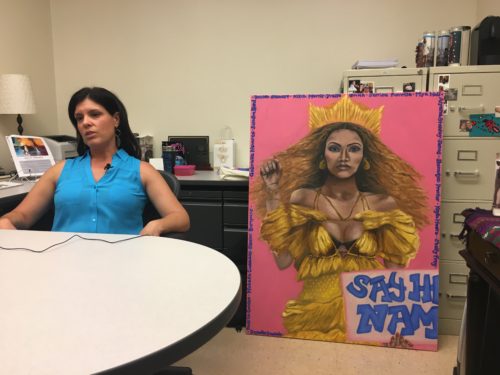I’ve never been more excited about a class than I was about my ethnic studies course, Beyonce: Feminism, Race and Politics.
The more and more I bragged about it to my friends I quickly realized that the majority of people either had no idea this class existed or, didn’t understand the relevance of the coursework. Being in senior project we’re supposed to pitch newsworthy topics and I thought how perfect this would be for a story.
Initially I pitched the idea of writing about “Bey Day”, this was my ethnic studies class final, which was a day dedicated to performances celebrating Beyonce and student/faculty panel discussions of black feminist authors. Brady was all for it, then quickly realized that Mustang News would be covering this event as it needed a more timely coverage.
As I continued to try to fight for covering this story, bragging about my professor, Dr. Navarro, listing off her accomplishments and trying to prove that she was unique enough for this story, Brady stopped me and said, “why don’t you do a feature on her instead?” I was surprised because I honestly assumed that Mustang News had written about her before, but after checking the archives I was delighted to move forward on shedding the spotlight on one of my favorite professors.

I wanted to make sure that I wasn’t her only number one fan, and asked former students about her and got nothing but positivity and even when I was checking out her Poly Ratings,
“Dr. Navarro was amazing!”
“Navarro is such a chill teacher.”
“Dr. Navarro is the BOMB. She is such a good lecturer and easily engages you in the topic that is covered that day.”
“Dr. Navarro is A-M-A-Z-I-N-G. Simply put, she is extremely kind hearted, understanding, patient and overall a brilliant woman. Her class was one of the most interesting ones I have ever had in my life and I loved every minute of it”
I wasn’t disappointed, so I wanted the readers to understand where this sentiment was coming from.
Nicole Peterson was writing the story, so I set up an appointment for her to meet Dr. Navarro; Dr. Isom, the head of the ethnic studies department; two of Dr. Navarro’s students; as well as her partner Dr. Navarro. I accompanied Nicole (and Annie and Lauren) to Dr. Navarro’s office where she had made the small space her home. She had 3 bookcases overflowing with texts of Chicano studies, the history of hip hop, and indigenous studies. Her glass award was tucked away in the corner of the desk, almost invisible to the eye. (She didn’t even mention the awards until I probed about it)
After Nicole finished her portion, I followed up with a few questions of my own:
What kind of struggles did you face bringing the Beyonce course on campus?
What is your favorite course to teach and why?
What are some of your professional, academic and personal goals?
What are some of your proudest moments as a professor?
Tell me about the ‘colonial bros and navahoes’ incident
Where do you see yourself in 10 years?
What did you want to be when you were younger?
Annie Vainshtein, was handling multimedia this project. I suggested that her Thinglink hotspots should include interviews with: former students, her partner and fellow colleague Dr. Navarro, and her department chair Dr. Isom. That way readers could get a glimpse of Dr. Navarro through different perspectives.
For her second component, I suggested a Storify, so that we could compile all of her published works and publicized events so that the reader could learn more about her credibility and some background to her academic and professional carer.
“It was really wonderful to work on this piece about Professor Jenell Navarro,” Vainshtein said, ” I haven’t worked on a profile piece in a while, but they’re some of my favorite interviews to watched and pieces to read. I loved the way multimedia was incorporated into the project and I think it served well to illuminate just how significant Dr. Navarro is for many students on campus.”
Lauren Roberge’s portion was broadcast, so she joined, Annie and Nicole and I for Dr. Navarro’s interview to film her video, “I really enjoyed getting to know Dr. Navarro and what she stands for. It’s inspiring to see someone work as hard as she does to make a difference in the issues surrounding racial injustice on campus and at home” she said.

We wrapped up the interview with a few portrait shots and then Dr. Navarro finally went. Nicole and I stayed after chatting about the incredible quotes she gave us brainstorming what we should lead with when Peterson said, “just from meeting Dr. Navarro I can tell what a great person she is, I really wish I had met her sooner in my Cal Poly career”.
This project was so much fun to work on because the other stories we’ve done are little more reporting based and though this was still a feature, I still believe it will force the reader to think critically about ethnic studies courses and the struggles that marginalized individuals face. Dr. Navarro is more than qualified to be teaching a course on black feminism and it is clear that her success isn’t measured by the awards she has received but by the bond created by her and her students, “I asked the students around the table, ‘what is a relevant education to you?’. ‘What makes ethnic studies a relevant education,’ one of my Chicana students said, ‘is an education that makes me relevant’ and I’ve always remembered that she just stated it so poetically and beautifully that the demand for ethnic studies is a demand to make a way for us to be here and not lose our sense of self. So that was a very proud moment for me to hear her express herself in that way…..”
-Mariam Alamshahi